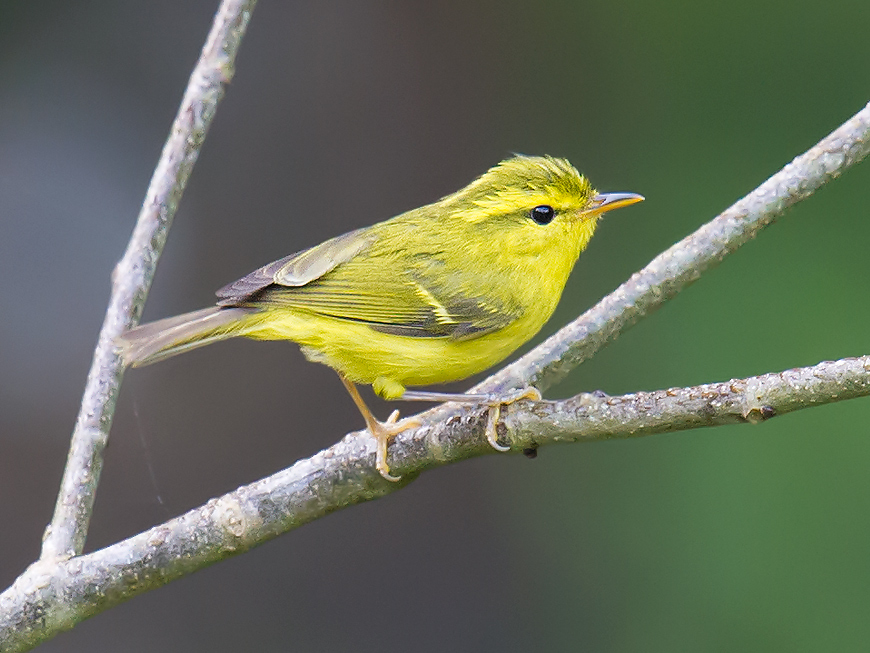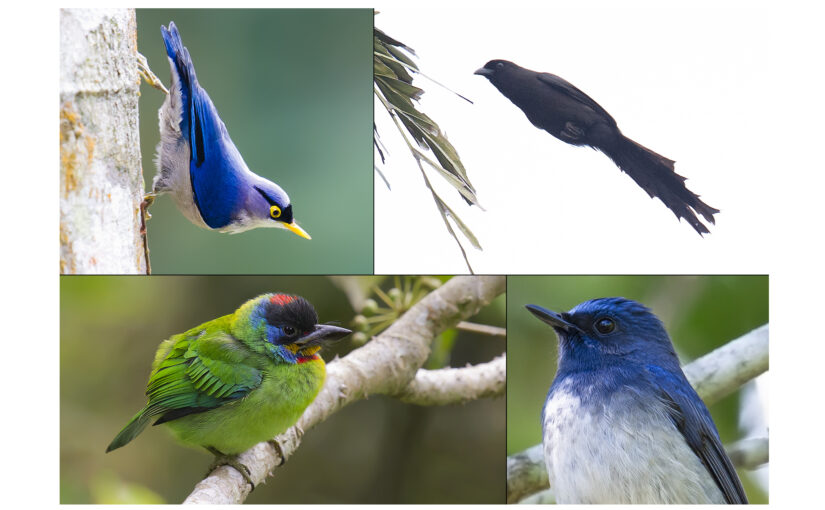by Mark Havenhand
for shanghaibirding.com

It had been eight years since Craig Brelsford published his report on Jianfengling National Reserve in Hainan, China, so what has changed in the meantime? In January 2022 I found out.
Travel in China during Covid times is subject to ever-changing rules and uncertainty. But with Shanghai suddenly declared low-risk, I took a chance and flew to Hainan to visit Jianfengling. Nobody asked for the fresh PCR test in my pocket, and I walked out of Sanya airport without fuss. A pre-booked taxi direct to one of the few hotels accepting foreigners got me to the Shanshui Jiudian in Jianfengling Village, about a kilometre from the park entrance. The hotel is rather basic, but it grew on me. I booked a room on the fourth floor with a balcony overlooking the gardens and mountains. I paid 180 yuan per night, a price I found reasonable. Smoking policy is as per 1970, and it is definitely oriented to Chinese tourists. Interestingly, they have a little natural history museum (ask) with well-preserved botanical specimens, insects, and some birds past their prime.
I strolled up to the park entrance to check opening times, costs, procedures, etc. This was a big mistake. They told me entrance was only by vehicle, 55 yuan a ticket, and opening hours 8 am to 5 pm. They did say a motorbike is OK as a vehicle. I tried that evening to rent one, without success—the village people insisted the mountain road was too dangerous for a foreigner on a bike. Knowing nothing better, I had to believe them, and I arranged a car.
Next morning began my daily commute about 20 km (12.5 mi.) up the mountain. Protocol is the driver pulls up to the park barrier, waves—and in you go, at any time of day. The park entrance lies at an elevation of 125 m (410 ft.). The weather here is tropically warm, while the mountaintop is perfect during the day, cold at night. Anyone planning nocturnal owl hunting should be equipped with jacket, hat, and gloves.
The initial flanks of the mountain are almost 100 percent encroached by palm-oil, tea, and vegetable plantations. Then there are two lookout stations, where I got my first Hainan Leaf Warbler. I walked on the road for 15 minutes from the first lookout and spotted, observing me from a low branch, Collared Owlet. I was beginning to like Jianfengling. The road summits then drops over about 3 km to Tianchi Lake (18.742621, 108.860669). Surrounded by mountains and greenery, it looks idyllic—see later. Tianchi usually had bored tourists present. Most of the places seem abandoned or close to it, and there is no tourist infrastructure beyond a few farm-restaurants and very simple shops.
There is a boardwalk I think all around it, in bad repair with signs saying keep off. If you do not keep off, then you can find many warblers, among them Arctic Warbler and Two-Barred Warbler. I knew nothing about the park at this stage, so I had told the taxi driver Mingfeng Valley from a sign by the roadside, simply to give him a clear target and because it sounded nice. There are good places to bird off the road between Tian Chi and Mingfeng (it is only 3 km or 2 miles; you can walk it easily). Where a stream crosses the road I got my first White Crowned Forktail and first of many Puff-throated Bulbul. I reached Mingfeng Valley, where the road stops in a rather dark and dismal car park (18.744938, 108.844438) next to the hotel at an elevation of about 950 m (3,120 ft.). The car park invariably has more bored and noisy tourists—but is the site of the famous Loop described by Craig. This is a boardwalk leading up the mountainside, 98% in deep primary forest. There is only one section that opens up into a view above the treetops rather than looking up from below. There are some disused buildings decaying by the start, and then it is more or less untouched forest. In January, the dry season, the trees lose some of their leaves, so the birds are more visible.
First impression of the Loop was disappointing. There were three reasons for that. First, my expectations were sky-high. Second, I arrived about noon, and at Jianfengling the birds have a marked siesta from around 11 a.m. to 3 p.m. Third, there were other people doing the walk. The wooden steps echo the sound of footsteps; in addition, some people feel the need to walk with sticks tapping out the sound of each footfall, and finally a not insignificant number of people seem to wish to fill the sound vacuum of the forest by making plenty of their own. Even pensioners whoop it up. Add onto this the fact that most forest birds are naturally shy—you rarely are closer than about 50 m—and your disappointment is assured.
I decided to go off-piste, taking the side path to the rustic toilets then carrying on off the boardwalk, curve to the right, down to the stream, walk upstream in it 30 m—and reach Paradise Valley. Here I found thick forest and water, a very good combination for birds at Jianfengling. Suddenly I am in a different world. I find Red-headed Trogon, Silver-breasted Broadbill, White’s Thrush, Orange-bellied Leafbird—definitely more like it. I carried on, crossing the stream and heading up to the mountain road. This turned into one of my favourite walks. There were no other people at all, maybe one or two vehicles per day on the road, and the road gave changing views into, up to, and down on the forest—so giving different birding chances. On reaching the road, with a little scramble turn right (uphill, but you cannot tell at first). This is a good area for Red-flanked Bluetail, then continue about 200 m to where the same stream of Paradise Valley cuts across the road, which curves right. If you have walked up from Mingfeng this is a good place to rest—but don’t take my word; ask the four species of thrush that live here and apparently nowhere else in the park (at least I did not see them). We already mentioned White’s Thrush, add Japanese Thrush, Eyebrowed Thrush, and Red-throated Thrush (I saw it clearly). The thrushes enjoy a scrap with numerous bulbuls, Huet’s Fulvetta, Dusky Fulvetta, Grey-chinned Minivet, and Scarlet Minivet.
Those tiring of adventure can continue another 100 m then take the obvious path to the right leading through nice undergrowth back to the Loop, which will surprise any tourists seeing you emerge. Those up for it can continue on and up to a beautiful sunny “terrace” where the road flattens out at an elevation of about 1050 m (3,450 ft.). Here is a good spot for Blue-bearded Bee-eater sitting on treetops and doing the standard takeoff-and-return manoeuvre of their family. But be careful—its timidity makes a pitta look like a pet, and I never got closer than 100 m. The thick woods are good for Black-throated Laughingthrush and Rufous-cheeked Laughingthrush, various pigeons could be heard but never seen, and Crested Serpent Eagle wheeled and cried below. The path tops out at elev. 1250 m (4,100 ft.) with a military base and some delightful woods with Green-billed Malkoha. One time very high—I guess another 500–1000 m higher—a large eagle turned and waved. Another time I caught a glimpse of a dog- or leopard-sized black animal deep in the forest. On the left side are some steps leading up to a radar station. There is a rusty pictogram indicating not to go—you may not notice it. Looking down the other side of this mountain is a very attractive looking valley I named Awesome. (If anyone goes, please send a report.) So now you have to retrace your steps and end up back on the Loop.
The next day I went back at daybreak (around 7:15 a.m. in January) and was the first one on the Loop, hightailing it to Craig’s “midair garden” before the first party of tourists arrived (I had seen them marching purposely from Tianchi). Was it worth it? Well, I had a nice sighting of a Hainan Giant Flying Squirrel with its magnificent bushy tail, making the Hainan Silver Pheasant and Black Bulbul seem like a sideshow.
I had found my go-to route—sure to see something and enjoy the calm and climate, perfect at that altitude. I did this path about three times, including an idyllic last day. But being restless, I wanted more.
I visited Zhufeng Peak. The road forks as it enters the park. Go straight and you go to Tianchi. Turn right and you end up at the base of the highest peak, called Zhufeng. This being China, there were some surprises—first, the carpark is full; second, there are rustic restaurants aplenty; third, the whole way to the summit is Loop-style wooden steps. Always one for a summit and having no idea how far, I got some water and set off, only to find 300 people coming down. Yep, youngsters drive there early, walk up in the dark, see sunrise, then all head down together. So the best time to go is probably about 9:30 to 10:30 a.m., when the sunrisers have quit and it is still cool. I took an hour and a half to walk up. The view from the top is amazing, and I recommend you do it, even though I found no birds to speak of except a Siberian Blue Robin feasting on crisp fragments on the steps.
In the post-summit glow of achievement, back in a baozi restaurant I asked the owner where the road carries on to. “Nowhere,” he said. Great, I thought, exactly what I want. This road was one of the most productive stretches I found. Even only 200 m away from the noise of the carpark was an enormous mixed feeding flock—full tree height, with Black-throated Laughingthrush at floor level, Yellow-billed Nuthatch, Grey-capped Pygmy Woodpecker, Hair-crested Drongo orbiting, numerous minivets, White-bellied Erpornis, a handful of squirrels, etc. etc.—the best flock I ever saw. On this lonely road I also saw the first of three Indochinese Green Magpie and more Blue-bearded Bee-eater. All days at Jianfengling were good, but this was the best.
Scrutinising the poor map, I spotted another road. Next day we head for Deer Shaped Tree. Oh my—if you wish to see nature-as-spectacle go there and despair—an enormous metal staircase is being constructed around the poor tree—in my opinion adding no value—the opposite, rather. Anyway, we carried on the road, scaring off 3 Rufous-cheeked Laughingthrush. In summary, this area was good, but not as good as Zhufeng Peak. The road seems to lead eventually to a village. I turned around before it.
After four forest days, I decided to take a break. I had seen on eBird Yinggehaizhen as a site and could see the salt flats from Zhufeng Peak. I also heard from guide Bella about a place called Fengtang which, I thought, might be the same (it is not). So to Yinggehaizhen (18.5100898,108.6885638) I went. A lot of plastic greenhouses reminded me of the industrialisation of farming and southern Spain. Anyway spirits lifted at the salt evaporation ponds, which are huge. The taxi driver took me to the tourist salt-making centre/museum—no need to go there, but they did seem to have an air-conditioned cafe, which could be very useful for future birders to note, as it is hot out on the flats. Soon I got onto a dirt path with a muddy creek one side, small bushes and salt-flat on the other. Bird bingo! Forty-one species in two hours. Two crakes within 300 m of the road and next to each other Ruddy Kingfisher, White-throated Kingfisher, numerous Common Kingfisher and Black-capped Kingfisher, and a lifer for me: Blyth’s Kingfisher. I also had Yellow Bittern, Brown Shrike, numerous Dusky Warbler, and a host of shorebirds, among them Black-winged Stilt, Black-tailed Godwit, and Great Knot.
Finally I return to the Loop. The Mingfeng carpark hotel takes foreigners. I wanted to see Hainan Peacock-Pheasant so booked two nights in a “birdwatching room” (nr 301 is excellent). The sun hits the trees opposite the hotel about 7:30 a.m., and for the next hour they are alive with birds. There is a roof terrace ideal for photographers at the hotel. I saw Green-billed Malkoha, Chinese Barbet, Red-headed Trogon minivets, Black-winged Cuckooshrike, Indochinese Green Magpie, Ratchet-tailed Treepie, Blyth’s Shrike-babbler, etc.—all within 50 m of the hotel. Doing the Loop at lunchtime (tourists are eating) or late afternoon was also productive—Greater Racket-tailed Drongo was added to my growing list. Another birder told me the secret to Eyebrowed Wren-Babbler—they live near the “big rock with Chinese characters” at the top of the Loop and respond well to phishing. I had two almost feeding out my hand instantly. A lovely bird.
What is my conclusion regarding the Loop? At the right time of day, with no one present, it is good. A wrong time and with tourists you will only benefit from the exercise. I never saw the peacock-pheasant nor any pigeons and very few woodpeckers. And what about Craig’s “Magic Roof Terrace”? I think it is about 150 m on the Loop in the official counterclockwise direction. The way is blocked by barbed wire, easily stepped over. It is more in the forest than the car park terrace. I saw Sultan Tit there.
Birding around the Shanshui Hotel was also productive. I saw Hodgson’s Hawk Cuckoo on two occasions, finally got a pale Hainan Blue Flycatcher, Blue Rock Thrush, an unidentifed nightjar, and an unidentified flock of mynas.
So I hope it is clear that Jianfengling is an ideal winter birding spot—easy to get to, at least some hotels that will accept foreigners, freedom to roam, and plenty of birds. First impression of the Loop corrected itself—for sure I would not spend all my time there—but especially for photographers, it is ideal. How about the first impression of the park as a tropical wilderness? Unfortunately that is not true. The park faces several immediate and mid-term threats. It may burn down—despite the no-smoking signs and “danger of fire”, the workers employed by the park to fix the steps, etc. uniformly smoke in the dry season. Secondly, encroachment—significant acreage has already been lost to small-holders, and the process continues. Much of this is screened off by a few meters of mature trees. The loss of habitat (let’s not mention land theft) is one aspect, the heavy use of pesticides another. These “gardens” have the sulphur-smell of malathion and long-banned organophosphate insecticides. For me at least, these chemicals are a bigger worry than habitat loss. In addition, there is substantial water diversion—almost every stream has white PVS pipes leading water away (theft?) to private gardens. Poaching is also evident—both for large mammals, presumably bears, as well as ubiquitous semi-hidden shooting platforms for birds. Finally, the park needs to engage with its environment. The Hainan coast is successfully developed as a tropical China tourist location, but what experience does the park offer such people? Not much, I am afraid. There is no attempt made to educate visitors about the value the park adds and why they should support it. I am sure many leave having seen essentially no wildlife.
So we birders may enjoy the Loop where these forces are not visible—but for how long?
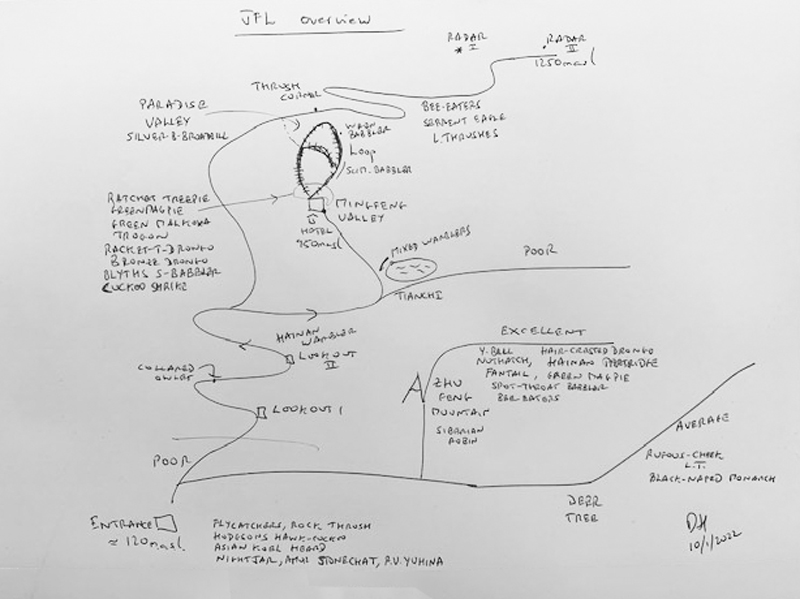
MORE ON HAINAN AND SOUTHEAST CHINA
shanghaibirding.com is an authority on birding China’s southeast. Use these resources:
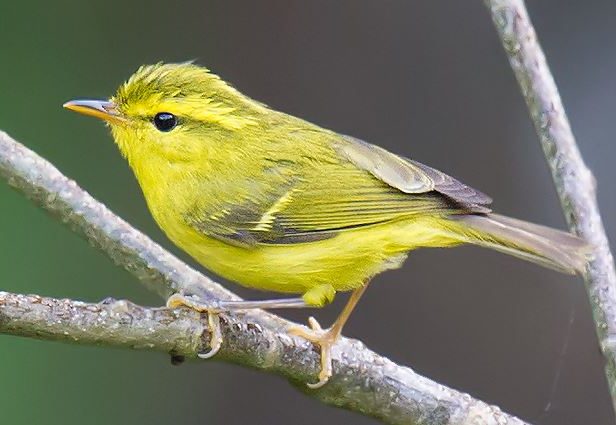
• Hainan Peacock-Pheasant & Other Endemics on Hainan Island: shanghaibirding.com founder Craig Brelsford spent most of his 28-day expedition at Jianfengling on the southern part of Hainan. Brelsford noted 26 endemic species or subspecies, among them Hainan Silver Pheasant, Hainan Peacock-Pheasant, Hainan Partridge, and Hainan Leaf Warbler. Brelsford also found Ratchet-tailed Treepie and Yellow-billed Nuthatch, species in China found only on Hainan.
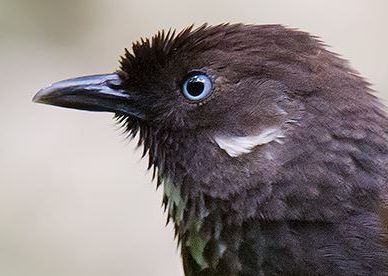
• Nonggang Babbler and White-winged Magpie in Guangxi: In the picturesque karst-country village of Longheng, Guangxi, birders note Nonggang Babbler, tick White-winged Magpie, and discover south China favorites Red-headed Trogon and Long-tailed Broadbill.
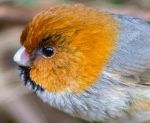
• Tianmu Mountains, Zhejiang, Home of Short-tailed Parrotbill: The Tianmu Mountains lie 250 km (155 mi.) southwest of Shanghai. There, birders tick Elliot’s Pheasant and Short-tailed Parrotbill. Crested Bunting sings, Chestnut-winged Cuckoo seeks nests to parasitize, and Buffy Laughingthrush finds a home here. Other goodies include Crested Serpent Eagle and Koklass Pheasant.
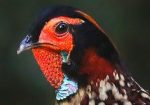
• Cabot’s Tragopan & Elliot’s Pheasant at Emeifeng, Fujian: The stars of Emeifeng are gamebirds Cabot’s Tragopan, Elliot’s Pheasant, and White-necklaced Partridge. Birders find as well dozens of south China species such as Blue-throated Bee-eater, Yellow-cheeked Tit, and Grey-sided Scimitar Babbler.
Featured image: Notable birds from Hainan, China. Clockwise from top L: Yellow-billed Nuthatch Sitta solangiae chienfengensis, ssp. endemic to Hainan, Jianfengling Nature Reserve (18.744568, 108.843043), elev. 980 m (3,210 ft.), February; Ratchet-tailed Treepie Temnurus temnurus, in China found only on Hainan, Jianfengling (18.744490, 108.843028), elev. 980 m (3,210 ft.), February; Hainan Blue Flycatcher Cyornis hainanus hainanus, Tianchi Lake (18.746527, 108.861234), February; and Chinese Barbet Psilopogon faber faber, ssp. endemic to Hainan, Jianfengling (18.742395, 108.840070), elev. 1080 m (3,530 ft.), January. (Craig Brelsford)
